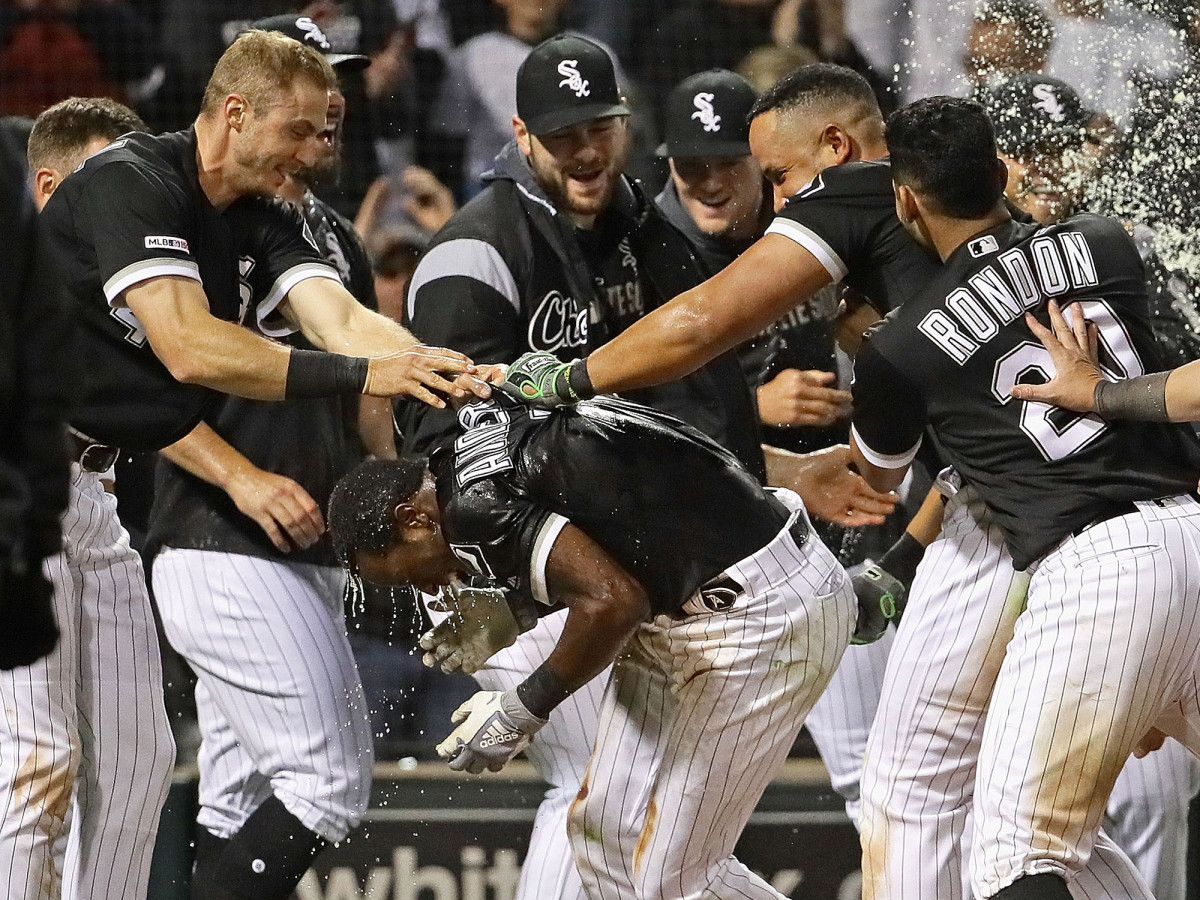Tim Anderson Is Going to Play the Game His Way

This story appears in the May 6, 2019, issue of Sports Illustrated. For more great storytelling and in-depth analysis, subscribe to the magazine—and get up to 94% off the cover price. Click here for more.
Tim Anderson’s baseball life is often a lonely one—even when he’s on first base, usually the most social stop on the diamond. “My conversation is limited over there,” he says. “It’s like, What’s up, dude? What’s up, man? How you doin’ today? Because we don’t have nothing in common.” He doesn’t speak Spanish; he doesn’t hunt or fish. “I don’t even want to touch a fish!”
Anderson, the 25-year-old shortstop hitting a league-leading .375, is the only African-American on the White Sox roster, making him one of only 72 black players in a game that, percentage-wise, was more than twice as black as recently as 1994. For Anderson, though, this is not just a matter of statistics. He says he feels out of place in baseball, like he belongs on the field but not in the game.
Most days, he keeps this problem to himself. But sometimes it surfaces. On April 17, in the fourth inning of a lightly attended home day game, he cracked a two-run homer to deep left to put Chicago up on the Royals. The moon shot became notable for what would follow it. As he was leaving the batter’s box, Anderson spun to face his dugout, and he fired his bat toward it in triumph before rounding the bases. When Anderson came up next, leading off the sixth, Kansas City pitcher Brad Keller fired a 92-mph fastball at his backside, and the benches cleared. Major League Baseball suspended Keller five games for throwing at Anderson and Anderson for one game for what it called his “conduct”: He had allegedly called Keller, who is white, a “weak-ass f------ n-----.”
I take your bat flip and raise you a bat TOSS. Cocky. Awesome.
— SI MLB (@si_mlb) April 17, 2019
(via @Cut4)pic.twitter.com/DkVORS4dXR
A week later, during a chat at a Starbucks in Baltimore, Anderson is even-keeled as he reflects on what he calls “the incident.” What did you call him, Tim?
“I called him a weak-ass f------ n-----,” he says. “That’s what I said.”
He doesn’t regret it. He doesn’t think he deserved to be suspended. He doesn’t think baseball’s mostly white hierarchy should be allowed to tell him when and how he can use a word that for two centuries has been used to oppress his people. “That’s a word that’s in my vocabulary,” he says. “When’s the last time [MLB chief baseball officer Joe Torre] heard that word?” (A spokesperson for MLB says, "There is diversity at the senior levels of MLB, including a Senior Vice President of Baseball Operations, an Executive Vice President of Baseball Development and a Chief Diversity and Inclusion Officer. The expertise of these individuals is valued and constantly relied on, including in situations like this.")
Benches clear in Royals-White Sox after Brad Keller hits Tim Anderson in the 6th inning. pic.twitter.com/u9IhZ56AvP
— MLB (@MLB) April 17, 2019
He doesn’t think baseball, or America, has made as much progress on questions of race and fairness as we would like to believe. He has not heard fans yell the n-word at him, as then Orioles centerfielder Adam Jones did in Boston in 2017. But as with Cubs reliever Carl Edwards Jr., who recently received hateful messages on Instagram (the league is investigating), Anderson has seen such invective directed at him online. He has not reported it.
Sometimes the indignities are smaller. After the Royals series, he tore up his left thumb sliding into second in Detroit, so he dug around in the team first-aid kit until he found a one-inch dot the color of flesh—someone else’s flesh. “That’s small stuff,” he says. “We got bigger problems.” But it is symbolic of his place in his sport in 2019. Anderson plays a white man’s game, and he plays it in a white man’s Band-Aid.
To whom does baseball belong? Is it the people who make its rules? The people who play it between the lines? The people who watch it? And what about when those groups disagree?
Baseball says it wants Tim Anderson. Anderson isn’t convinced. After the bat flip, MLB’s official account tweeted, “Keep doing your thing, @TimAnderson7.” But there’s a welt on his backside and a suspension on his résumé that testify otherwise about what thing exactly the game wants him to keep doing.
Keep doing your thing, @TimAnderson7. 👏 #LetTheKidsPlay pic.twitter.com/9irMSsyFZ2
— MLB (@MLB) April 18, 2019
The color barrier fell 72 years ago. Anderson honored the occasion by wearing number 42 on the anniversary of the debut of the man who broke it, as do all major league players and staff, and by hosting a private screening of 42, the 2013 biopic, for kids from the White Sox’ Amateur City Elite program, which introduces inner-city Chicago youngsters to baseball. But he sees another barrier, one he’s intent on toppling: the “have-fun barrier.”
“I kind of feel like today’s Jackie Robinson,” he says. “That’s huge to say. But it’s cool, man, because he changed the game, and I feel like I’m getting to a point to where I need to change the game.”
Anderson’s point is more nuanced than it might sound. Robinson remains an American hero, and Anderson will never face the Jim Crow horrors Robinson and the first generation of black major leaguers endured. Also, plenty of players, white and nonwhite alike, have had fun while playing the game.
But, as a rule, baseball does not encourage individualism. As other sports have evolved to showcase their stars’ personalities, the baseball old guard has held tight to its principles. Run out ground balls. Keep your mouth shut. Gently place your bat near home plate—a player should react to a home run just as he would react to the news that an acquaintance filed his taxes on time.
These attitudes often map along racial lines, though not always. Pirates righty Chris Archer, who is black, recently threw behind Reds first baseman Derek Dietrich, who is white, after Dietrich admired a home run. And perhaps no modern player is better known for his on-field emotions (and bat flips) than Phillies outfielder Bryce Harper, who is white. (Famously, Harper wore a make baseball fun again hat in 2016.)
Again, there is tension among the parties as to whom the game belongs: MLB’s recent marketing campaign has showcased the league’s young stars and their impassioned styles. “Let the kids play,” the ads exhort. But sometimes the other kids do not.
It’s October. Let the Kids Play. pic.twitter.com/1igMtzVDO1
— MLB (@MLB) October 2, 2018
Anderson’s complaint is not simply that Keller sought revenge for the bat flip. It’s that Keller received a five-game ban—which, for a starting pitcher, amounts to one missed game of action—for hurling a projectile at his body, and that Anderson received the same punishment for reacting, in the heat of competition, with a word that he believes he should be allowed to say.
He did not appeal the suspension, he says, because there would have been no point. “I don’t think there’s a black guy that’s up that high in baseball that they could drag in and be like, ‘Hey, what do you think we should do to this guy?’ ” he says. While the game has grown more diverse overall—41% of players today are of color, according to MLB statistics—Latin Americans have made up most of that growth. They too face a sense of isolation and discomfort, and they have been among the wave of players introducing emotion into the game, but the experience of a Latino is not identical to that of an African-American. At the moment, if Anderson wants to see someone who looks like him in his clubhouse, he has to look in the mirror.
For a long time he was quiet about all this. This season marks Anderson’s fourth in the majors; he had never before made waves for his play or his words. So why speak up now?
He had been dreading this trip to Baltimore for a while. This is the city where, on May 7, 2017, he awoke at 3 a.m. to a frantic call. His best friend, Branden Moss, was dead at 23, shot multiple times from close range while trying to break up a fight. Anderson sobbed. Moss had made smart choices. He was a high school football star, a college graduate. He had made time for a rare night out in their shared hometown of Tuscaloosa, Ala., to celebrate a friend’s graduation from Alabama.
Anderson took three days of bereavement leave, then tried to muscle through his emotions. His wife, Bria, whom he met in Tuscaloosa and married in 2016, begged him to seek help. “I was like, Man, I don’t need therapy,” he says. “I’m a man! I know how to handle my situation. But then I got to the point where I’m like, All right, I’m tired of feeling like this. I’ll try something new. I got better when I went to therapy. . . . You just sit in a room and you talk to somebody, and they just listen. You can hear yourself talking, and it’s like, Man, you are going through a lot.”

Moss was more than a friend. He was a steady force in a life that had undergone too much turbulence. Anderson’s father, Tim Sr., was in prison by the time his son was born, doing 15 years on a drug conviction. Tim Jr. was the fifth of Kim Clark’s children; her sister, Lucille Brown, and Lucille’s husband, Roger, ended up taking Tim in when he was born.
Anderson did not understand that his childhood was unusual until he got older. “Nobody ever told me what was going on,” he says. He just got used to spending some weekends with his mom and siblings, and others in the prison visiting room, playing board games and eating chicken sandwiches with his jumpsuited father. He got used to looking up at the stands at his Little League games and knowing neither of his biological parents would be there.
So when he takes three-year-old daughter Peyton to Disney on Ice, it’s hard to tell who is more excited. (These trips will soon include newborn daughter Paxton.) When he works with children through the Chicago-based violence-prevention program Becoming a Man, he says he gets as much out of the visits as his mentees do. They compare playlists and dance moves. They talk trash. The kids don’t bother to ask for photos. They just want to be his friend.
“When I was a kid, I didn’t have nobody to come in and talk to me,” he says. “I get my childhood back. That’s why I want to take my kids and do things that I didn’t do, because it’s an experience for me, too.”
Anderson had played Little League as a kid, but dropped the sport until his junior year of high school, when knee injuries kept him off the basketball court. He was light on baseball tape, so he sent major league scouts video of himself dunking—after two seasons at East Central (Miss.) Community College, he wound up being drafted No. 17 overall in 2013.
Still, he wants at-risk kids to pick up a bat. Football is dangerous; basketball is for physical freaks. But an otherwise unremarkable child can dedicate himself to baseball and give himself a shot at college. Maybe more: Four years after drafting him, the White Sox signed Anderson to a six-year, $25 million deal. Baseball changed his life. So he signs autographs and poses for photos and donates equipment.

He might have been comfortable doing that and that alone if not for Moss’s death. Anderson had always felt the swagger inside himself, but he was afraid to let it out. Moss, though, was fearless, no matter what he was up against. “I don’t care who you is,” Anderson says of Moss’s attitude. “I’ll whoop you.” Anderson began to wonder if he was really honoring his friend by living another life, a life that wasn’t his. This offseason he told Darrius Chapman, his friend and manager—and the person who delivered the news of Moss’s death—that he had big goals. He wanted to break “the have-fun barrier.”
He considers the contrast between the way NBA players walk into stadiums as if they are stalking a catwalk, and the rumpled shirts and cowboy boots he sees around him. He has dreams of starting his own fashion lines—one athleisure, one urban—and he dresses for the job he wants. He owns hundreds of pairs of sneakers, spread across his two homes and Chapman’s. On Jackie Robinson Day, he wore a bow tie, suspenders and a flat cap.
But none of what he hopes for will come without more months like this past April. When Anderson flipped his bat, Blue Jays centerfielder Randal Grichuk appeared to take a shot at him on Twitter: “Guys are getting a little excessive on pimping HRs, on meaningless HRs too. Act like you have done it before, one time.”
😂 Put a name on so we can see who you talking bout bra💯
— Seven (@TimAnderson7) April 18, 2019
“Put a name on so we can see who you talking bout bra ,” Anderson fired back. (Responded Grichuk, “Guy, are you really responding to my tweet . . . SMH. It wasn’t intended for anyone specific but clearly you responding shows you’re guilty of something.”)
He has not spoken to the Royals. He does not intend to. “I want to be that guy you don’t want to play against, because I’m a dog,” he says. “My team loves it, so I don’t care about anybody else. That’s what you get when you come to the South Side. We’re going out and trying to whoop your ass.”
Chicago holds the second-largest black community in the country, about 900,000 people. He wants to inspire them. He wants to show them what someone who looks like them can do. “I’m bringing something to baseball that’s never been brought, as far as the swag,” he says. “I love fashion, and just being different, and bringing black culture to baseball and doing it in a different way, because today’s game is boring. . . . [After the bat flip,] a lot of people who don’t watch baseball, they actually gave me feedback, like, ‘Man, if this is going on in baseball, I better watch it.’ ”
On April 26, with the White Sox and the Tigers tied and two out in the bottom of the ninth, Anderson demolished a belt-high slider. His bat was still in his hands as he saw the ball clear the leftfield wall. I’ve got to do it, he decided. He launched the lumber toward his teammates, who were spilling out of the dugout, preparing to douse him in yellow Gatorade. Anderson grinned and circled the bases.

